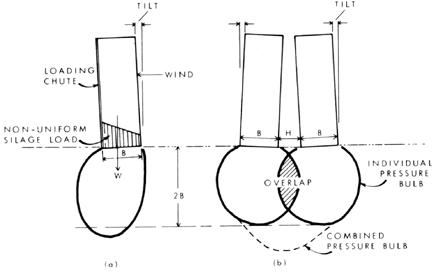1.7 Tower Silo Foundation
Tower silos, tall, bullet-shaped farm structures, are used to store forage crops for feeding cattle. The first tower silos, constructed about 40 years ago, were small, predominantly wooden structures although a few were made of concrete. Since then they have increased in number, size, and capacity, most made of concrete but some of steel. Some recent structures are fully automated exceed 100 ft (31 m) in height, and have a storage capacity of more than 2500 tons. Over the years silo builders have improved the design and construction of the above ground portion of silos but, in contrast, very little have been done to improve the foundation. Towers have generally been erected on foundations prepared by the farmer, who often lacked the necessary technology for adequate design and construction. The practice was reasonably successful when silos were small because the bearing pressures applied to the soils were low. As bigger silos were erected, however, and the applied foundation pressures approached the bearing capacity of the soils, many structures settled considerably, some tilted, and some overturned completely. This Digest outlines the problem and indicates the need for a soil investigation to determine the allowable bearing capacity and compressibility of the soil and thus enable proper foundation design.
 |
| Fig. 1.6. Pressure bulbs under large and small round foundations |
Many tower silos constructed on clay soils have ring-shaped concrete foundations. To reduce costs, concrete floors are seldom provided. When the silos are filled with silage, part of the load is transmitted through the cylindrical walls to the footings and the remainder is carried directly by the soil inside the ring foundation. The underlying clays compress vertically under the weight of the loaded structure in such a way that the applied loads are distributed uniformly to the soil over the whole area enclosed by the circular foundation. This uniform pressure is distributed to the foundation soil in the form of a pressure bulb; its size and shape, determined by elastic theory, are related directly to the diameter of the loaded area as shown in Figure 1. Here, two footings of different size carry the same uniform load, but the pressure bulb under the larger foundation is much larger and deeper. In each case the maximum vertical pressure occurs immediately below the footing and diminishes to 10 percent of this value at a depth equal to twice the diameter of the foundation. If the applied stresses within the bulb do not exceed the shear strength of the soil the structure will be stable.
Non-uniform placement of silage during filling has caused many problems. When the load from the weight of the silage is off centre the pressure bulb will be distorted, as shown in Figure 1.7. Strong winds acting on a tall silo can produce the same effect. The local overstressing of the foundation soil may cause tilting, and unless the problem is remedied it may increase with time until the silo overturns.

No comments:
Post a Comment